#Hermetica
Text

Pharaoh’s Dancers 🪄🐍
#divine feminine#ancient egypt#melanin is gold#ancient kemet#black girl aesthetic#kemetic#kemet#bastet#isis#hathor#sekhmet#goddess#ancient art#ancient history#mythology#egyptian mythology#egyptian art#egyptian#egypt#melanin#thoth#hermes#girl blogger#astrology#saturn#hermetica#emerald tablet#black girl culture#africa#african mythology
58 notes
·
View notes
Photo

Hermetica: The Ancient Greek and Latin Writings which contain Religious or Philosophic Teachings ascribed to Hermes Trismegistus
#hermetica#corpus hermeticum#hermeticism#hermetic philosophy#egyptian philosophy#greek philosophy#hermes#hermes trismegistus#mercurius#thoth#ascelipius#hellenistic#late antiquity#library of alexandria#greco-roman egypt#emerald tablet#gnosis#gnosticism
201 notes
·
View notes
Text
“If then you do not make yourself equal to God, you cannot apprehend God; for like is known by like.
…
Think that for you too nothing is impossible; deem that you too are immortal, and that you are able to grasp all things in your thought, to know every craft and science; find your home in the haunts of every living creature; make yourself higher than all heights and lower than all depths;
…
But if you shut up your soul in your body, and abase yourself, and say “I know nothing, I can do nothing; I am afraid of earth and sea, I cannot mount to heaven; I know not what I was, nor what I shall be,” then what have you to do with God?”
-Hermes Trismegistus, Hermetica
***I don’t think Hermes and Thoth are the same gods, rather they are besties who vibe well and wrote books together.
And maybe Hermes Trismegistus (Hermes Thrice-Great) is not just a fusion/collaboration of two deities, but a trio. A trio of Hermes, Thoth and you. Thrice-great.
They said “If then you do not make yourself equal to God, you cannot apprehend God; for like is known by like.” in the Hermetica.
They already say if you wish to understand the wisdom of them, you need to think yourself as a god as well. For like is known by like. As above, so below, if you will.
Then you can share their wisdom. And be the Hermes Trimegistus.
Kharis Hermes! Dua Thoth! Hail me!
Disclaimer: Just some late night thoughts.
#hermes#thoth#greek mythology#egypt mythology#hermetic#paganism#hellenism#hermetica#hermes trismegistus#alchemy#kemetism
54 notes
·
View notes
Text
ΑΒΡΑΣΑΞ -- ABRASAX From a Hermetic Viewpoint.

To the Gnostics, Abrasax is the great archon who created the whole world. There is quite a bit of nuance considering how Basilides Gnosticism views this deity. Nuance that I am not qualified to go over at the moment. Carl Jung refers to Abrasax as a truly terrible entity that encompasses all evil and all good, in his Red Book. I've seen negative reactions from people on Discord to this entity, but also some positive reactions.
But to the Hermeticist…who and what is this weird rooster head, snake-legged deity that is found all throughout the Greek Magical Papyri (PGM)? Let’s find out?
In the Discourse of the Ogdoad and Ennead (D89) we are given strings of vowels and nomina Barbara for the Hermetic student, namely Tat as he is being taught by Hermes. To Christian H. Bull in his The Tradition of Hermes Trismégistōs, the string of Greek vowels and nomina Barbara/voces magicae is the totality of the Kosmos. Tat asks to receive the imprint of fullness by ways of hymns of praise to God. Bull seems to agree with Alberto Camplani that the “imprint of Fullness (Pleorma)” is coded within these string of vowels and voces magicae.
From personal experiences — I have to agree with this, but I had to fuck around and find out for myself as I read this book many months ago when vowels and voces magicae were not big in my praxis. Anyways, here is the full hymn:
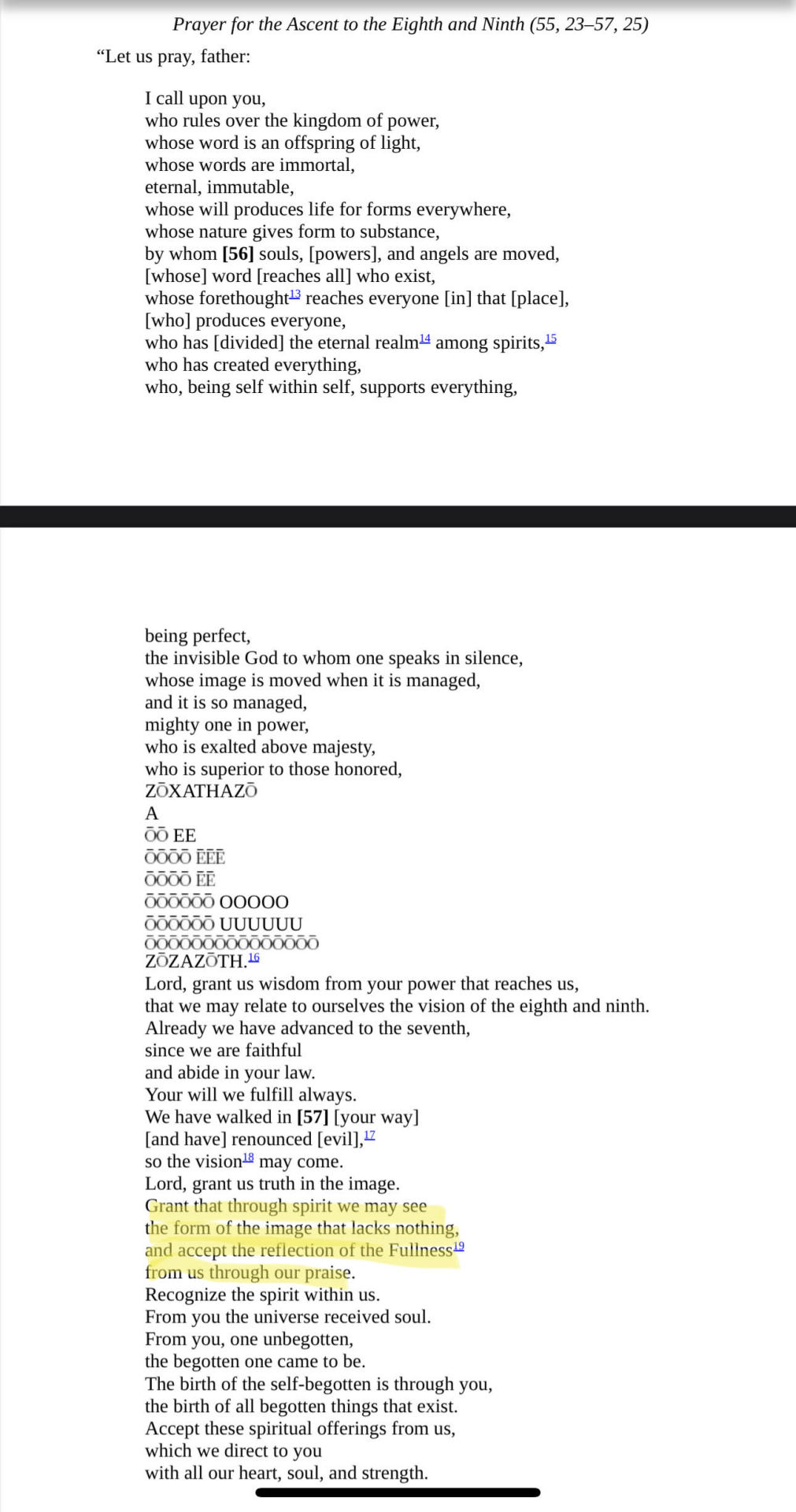
Great! So how does this tie into ΑΒΡΑΣΑΞ and what is this names value to a Hermeticist? For starters — This name, has a numerical value of 365, according to isopsephy. 365, as the majority of you know, is the totality of days our Earth revolves around the Sun. In PGM VIII. 1-63, specifically in lines 45-50… we see a love spell invoking Hermes to which we are given the name of ABRASAX equaling 365 explicitly, and quite possibly a voces magicae for Hermes.
The Sun's importance in Hermeticism is ever-present. Most explicit in my opinion is SH 2a from M. David Litwa’s Hermetica II:
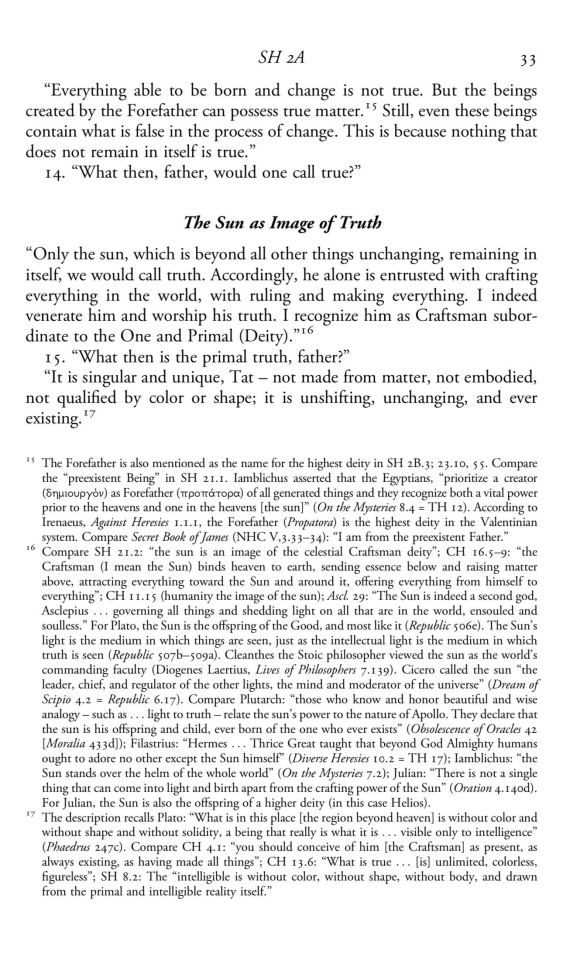
Also important to note: Thoth. Many believe Thoth is just the god of the Moon, yet Thoth has a Solar form: the Baboon. Baboons and their screeches are believed to be connected to the language of the gods. This is confirmed in the Demotic Book of Thoth. Where a scribe of Thoth’s Scribal College: The House of Life [𓉑], says this about the great teacher, Thoth:
"The signs revealed their form. He called to them and they answered to him. He knew the form of speech of the baboons and the ibises."
Thoth is also believed to be the creator of not just words and language but also vowels (Philebus 18b-c). For clarity's sake, Thoth is an extremely important figure in Hermeticism. Our teachings are based upon a syncretic god: Hermes & Thoth — Hermēs Trismégistōs.

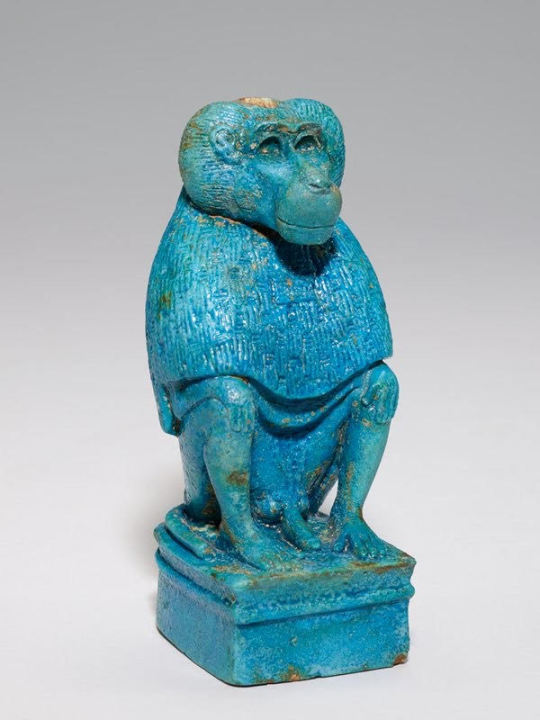
More evidence for the importance of ΑΒΡΑΣΑΞ is found in PGM XIII.1-343 — the famed Heptagram Rite, which we can perform more clearly and neatly here. This is a ritual that invokes Aiōn. Aiōn is believed to be the power of the Unknowable, Ineffable Godhead in Corpus Hermeticum XI. In lines 80-89 of PGM XIII, we are given voces magicae to Aiōn in 7 different languages as seen below.
Birdglyphic: ΑΡΑΙ
Hieroglyphic: ΛΑΙΛΑΜ
Hebraic: ΑΝΟΧ ΒΙΑΘΙΑΡΒΑΘ ΒΕΡΒΙΡ ΕΧΙΛΑΤΟΥΡ ΒΟΥΦΡΟΥΜΤΡΟΜ
Egyptian: ΑΛΔΑΒΑΕΙΜ
Finally, in Baboonic: ΑΒΡΑΣΑΞ
(The voces magicae for Aiōn is continued in 'Falconic' and lastly hieratic languages). Thus, we can see a clear link to baboons and Thoth, the name Abrasax to the baboons, and their "language." We see a connection between Aiōn and Abrasax, and we also saw above in PGM VIII that it could also be used as a voces magicae to Hermes!
But let’s look at the imagery as well. A rooster head with snake legs. The legs, to me, are Chthonic of course, and curl up to shape an Ω, the seventh sphere, Saturn. The connection to Omega is something Christian H. Bill points out. The rooster is also a Solar animal. So to me, we have a beautiful image representing the totality of All Things from the Sun whose an image of Truth, directly subordinate to the One Primal Deity (SH 2a), down to the Du’at/Underworld. Both Hermes and Thoth are connected to the Underworld as well as the Sun. Hermes' planet, Mercury is the closest planet to the Sun. Hermes is also famously known as a psychopomp, a traveler and mediator between Hades and Mount Olympus, Death and Life. Thoth, with His solar connections stated above, is also a key member of the Ancient Egyptian Underworld. In the Ani Papyrus, we see Thoth as the recorder/scribe that lists every heart that is weighed up against the Divine Feather of Truth -- Ma'at.

Thus what we have here, from a Hermetic standpoint, is that Abrasax is not a malevolent archon or a demon as denoted by the early Catholic Church, but rather a beautiful deity that is worthy of reverence whose name equals our revolution around the Sun, the Image of God. Abrasax — a name that is connected to both Hermes and Thoth, for reasons stated above. A name that also has a connection to Aiōn, an extremely important power/god in Corpus Hermeticum XI.
That is my interpretation, from a Hermetic standpoint. There are many interpretations of this elusive yet captivating deity. Abrasax can be a voces magicae for Hermes, or for Aiōn, it can be what I said, or you can take the Gnostic approach, or Jung, or Catholic approach to Abrasax. Regardless of what you do with the information, I shall continue to raise my voice in jubilation and cry out:
ΧΑΙΡΕ ΑΒΡΑΣΑΞ !
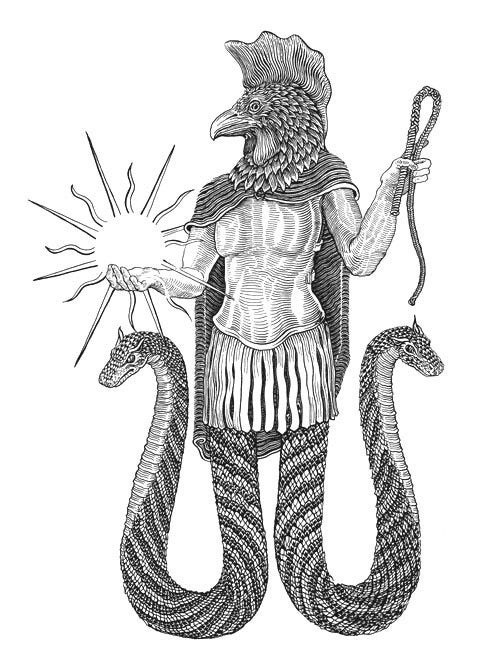
#hermeticism#gnosticism#demon#aion#greek magical papyri#corpus hermeticum#Ogdoad#ennead#nag hammadi library#Abrasax#archon#hermetica#magic#ritual#spells#hermes trismegistus#hermes#thoth#greco egyptian#egyptian#Greek#mythology#underworld#sun
21 notes
·
View notes
Text
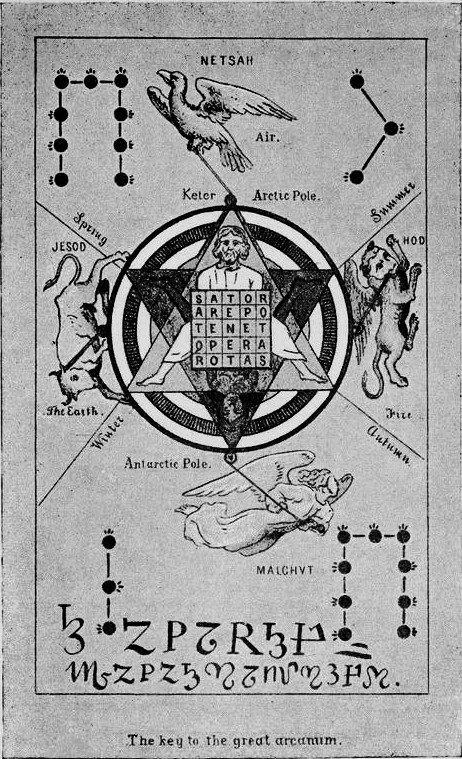
Key of the Tarot: there are four suits, wands, caps, swords, coins or pentacles, corresponding to the four cardinal points of Heaven, and the four living creatures or symbolic signs and numbers and letters formed in a circle; then the seven planetary signs, with the indication of their repetition signified by the three colours, to symbolize the natural world, the human world and the divine world, whose hieroglyphic emblems compose the twenty-one trumps of our Tarot. In the centre of the ring may be perceived the double triangle forming the Star or Seal of Solomon. It is the religious and metaphysical triad analogous to the natural triad of universal generation in the equilibrated substance. Around the triangle is the cross which divides the circle into four equal parts, and thus the symbols of religion are united to the signs of geometry; faith completes science, and science acknowledge faith. By the aid of this key one can understand the universal symbolism of the ancient world, and note its striking analogies with our dogmas. One will thus recognize that the divine revelation is permanent in nature and humanity.
#key of the tarot#bibliophile#literature#quotes#upload#occult#occult art#occultism#great arcanum#symbols#hermetica#hermetic alchemy#hermetic library#hermetismo#hermetic tarot#tarot#geometry
154 notes
·
View notes
Text

"my true nature is unaffected by circumstance" | elvenfoe
#sharing some of my previous sigils#sigil#sigils#my sigil#occult#hermetica#ritual#witchcraft#witch#sigilcraft#sigil magic#sigilwork#chaos magic#sigil magick#chaos magick#art
32 notes
·
View notes
Photo

From “Greek Enchiridion” c. 1553
#hermetica#hephaestion#snake#illustration#engraving#greek enchiridion#mysticism#symbolism#ex libris mythicus
293 notes
·
View notes
Text
For exploring esoteric topics like alchemy, hermeticism, and occult philosophies from more grounded, academic perspectives without promoting pseudoscience, here are some alternative recommendations:
YouTube Channels:
- Esoteric Book Reviews - A scholar provides overviews of key esoteric texts through an impartial lens
- Metaphysical Substance - Covers esoteric subjects like hermeticism, but separates fact from fiction
- Esoterica Etc - Examines occult influences in art/culture, while debunking pseudohistory claims
Online Resources:
- Public Domain Review - Excellent source for historical texts/art related to esoteric traditions
- Hermetic Kabbalah - Academic site exploring the historical origins of Kabbalah and hermeticism
- Alchemy Website - Maintained by a science historian, covers alchemy's scientific development
Books:
- "The Occult Mind" by Christopher Partridge - Overview of Western esoteric traditions by a religious scholar
- "The Hermetic Tradition" by Clement Salaman - Traces the history of hermeticism and alchemy
- "Giordano Bruno and the Hermetic Tradition" by Frances Yates - Scholarly work on Renaissance hermeticism
When exploring these sources, they will inform you about any pseudoscientific or unsubstantiated claims related to esoteric topics, but from an impartial, fact-based perspective. The goal is education over promotion of fringe theories.
You can learn about concepts like alchemy's symbolic principles or hermeticism's metaphysical ideas in their historical/philosophical context, without necessarily buying into them as literal truths.
#esoteric#occult#hermeticism#alchemy#metaphysics#gnosticism#ancientmysteries#esotericphilosophy#esotericknowledge#hermetic#hermetica#alchemicalsymbology#renaissancehermeticism#westernmystictradition#theoccultmind#knowledgeobsession#learningobsession#primarysources#academicresources#factsfirst#avoidmisinformation#studysmarter#ethicaleducation
12 notes
·
View notes
Photo
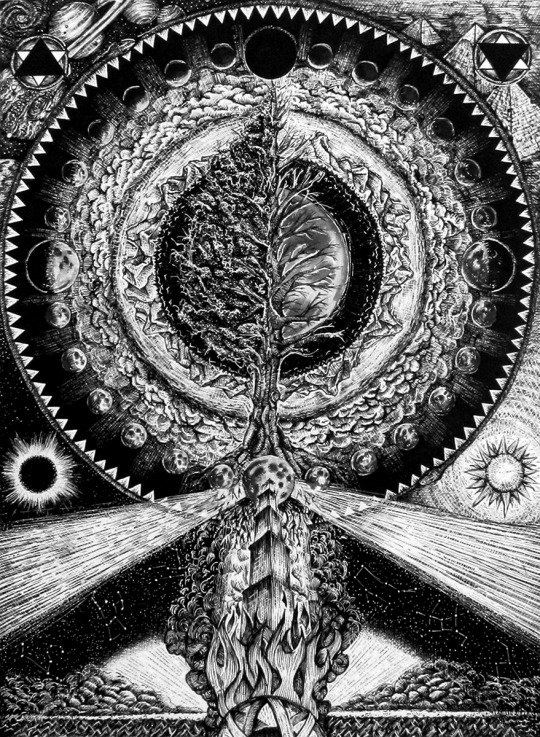
Let me try this again. Not sure I’ve shared this work on here before.
From: http://theprimitiverite.com/portfolio/anima-mundi/
57 notes
·
View notes
Text
Cuando el humano se hunde, siempre busca un responsable.
20 notes
·
View notes
Text
The [Hermetica] presents an image of human beings as star beings in corporeal disguise. Its various writings imply that, through a kind of alchemy of the soul, at once philosophical and mystical, the budding Hermeticist can transmute the clay of his lower nature into the golden light of gnosis, a mystic flash of luminescent knowledge that awakens the divine intelligence at the heart of the self.
Techgnosis - Erik Davis
5 notes
·
View notes
Text
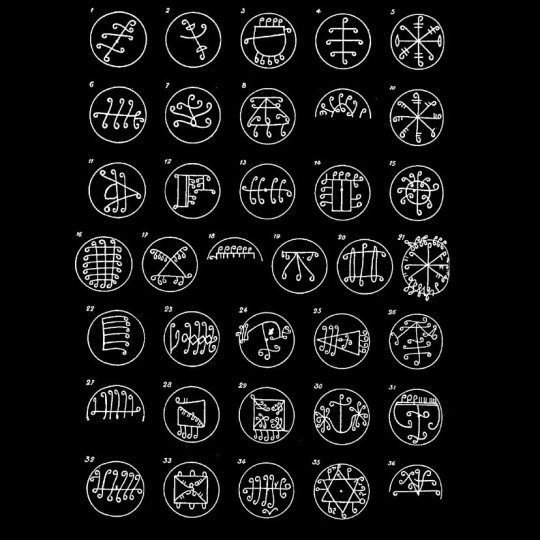
Sigils of the 36 Decans from the Catalogus Codicum Astrologorum Graecorum, a compilation of translations of Greco-Egyptian magical texts on the Decans and their uses.
The names of the Decans as given in the catalogue:
𓇼PARKHÁM
𓇼OUALÁKH
𓇼DELPHAÁ
𓇼ZAKKHÁL
𓇼KHOUNTHÁ
𓇼ANESIOÚM
𓇼PARESKHÁRTI
𓇼HIERASESÊR
𓇼ANASÁM-TETÊKH
𓇼SARKHAÁM-KOMPHES
𓇼TENOÚM-TANLÁKH
𓇼TROUKHÁP-IÁLEM, SAMPÁKH
𓇼APHÁKH-MPEÍTH, PANKHATÁP
𓇼TALANTÍS-KHARKHÁM
𓇼DEROPOÚT
𓇼MENAÍM-KHILLÁ
𓇼MPEÍ-PHOLÁKH
𓇼MARKHEM
𓇼ZÁKH-MEM
𓇼SEPTETÚL
𓇼SELOUÁKHAM
𓇼AMPÁNAN TZÉNGGIKH
𓇼LÁPH-MEÍKH
𓇼ARKHÍMOI-IELOÚPH
𓇼ANASÁM-TERIKHEM
𓇼MAKHRÁM
𓇼KHALKHÊM-IKHÉM
[Capricorn is missing]
𓇼BAZEÍNKH
𓇼KHOUNLIÁKHM
𓇼MAKHILOÚKH
𓇼KAÍN-KHÁM
𓇼POKH-MELLEPH
𓇼SUREM-OLÁKHM
#hermetismo#hermeticism#hermetic philosophy#hermetic library#hermetica#Egyptian decans#decans#decan spirits#star spirits#astrology#astrological magic#hellenistic astrology#ancient astrology#astrology witch#astrologycommunity#traditonal astrology#magicien#amulets#talismans#talismanic#sigil witch#sigil magic#sigil making#sigilcore#sigilwork#sigils#sigilyph#sigil creator#egyptian astrology
60 notes
·
View notes
Text


(Atum = God)
Hermes Trismegistus
The Hermetica
Timothy Freke & Peter Gandy
3 notes
·
View notes
Text
How I Structure My Hermetic Praxis with the Help of the Preces Templi PDF
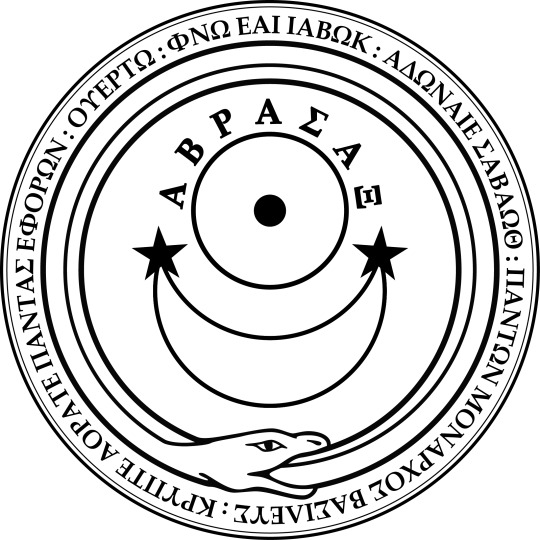
Now, without trying to tackle and unpack what a “Hermetic praxis” entails or means philosophically or scholarly, we are going to briefly summarize that it is a practice that includes adherence to the teachings of the writings attributed to Hermes [Trismegistos], along with an adherence to the teachings found in such tractates such as the Greek Magical Papyri (PGM) and Picatrix, and many other magical/astrological treatises. Does one have to use the Picatrix or PGM? No of course not. This is just what my Hermetic praxis looks like. Nothing in here is “canon” or dogma. I am just expressing how the Preces Templi e-book by the incredible Sam Block, aka “Polyphanes” helped me restructure my praxis with a strong adherence to the teachings found in the Corpus Hermeticum (CH), Latin Asclepius (AH), and the Definitions From Hermes to Asclepius (DH), to name a few. A link to his Ko-Fi shop will be at the bottom of the page. I encourage anyone who is looking to structure a “Hermetic praxis” with an adherence to classical “Hermetic” texts and treatise to investigate his shop and also come join us in the HhoL (Hermetic House of Life) discord server! These things I practice are mingled and co-exist with an already daily devotion to the gods of Egypt and Greece, which that devotion can be deemed “Hermetic,” most certainly, but not all the time. Alright, now that I’ve introduced what I am talking about. Let’s get into what I do upon arrival, upon waking up I mean.
The first words out of my mouth upon my arrival will be taken from Chapter 2.2.1 from the e-book “Opening Supplication.” I find that a quick little praise or thanks to The All helps keep me focused and more mindful of my day-to-day interactions with others. It also reminds me to give thanks to the gods before I embark on any task, mundane or spiritual. Allowing me to start and complete every task with Divine influence. If I don’t say this upon awakening from my slumber, I usually say this little maxim to Amun: “Awake being rested, may you awake in peace! May Amun awake in life and peace! May NN (I insert my magical pseudonym here) awake in peace!”
After washing and stretching, I’ll say the prayer from CH I. 31-32, which Polyphanes lists as the Triple Trisagion, in Chapter 2.3. A beautiful prayer that closes the first chapter of the Corpus Hermeticum. I personally don’t use his translation, simply out of practicality reasons, as it is easier to just grab my Hermetica translated by Brian Copenhaver than to open up my PDF file of the Preces Templi. Though if I’m on the go, running late, or whatever it may be, the Preces Templi e-book is always a few taps away for me to show my devotion just on the go!
Next, after the closing prayer from CH I. 31-32, I say the prayer in the back of book 2 of the Ars Paulina to my Holy Guardian Angel. Now praying to your personal daimon, HGA, natal genius, whatever you want to call it isn’t found in the Preces Templi, nor found in any philosophical Hermetica. A method to get in contact with your “Personal genius” is found in the Picatrix, an astrological treatise attributed to Hermes. To me, this suggests the importance of getting in touch with your personal daimon for a Hermetic praxis.
Moving on to when I’ll come home from school or work. I’ll meditate informally (meaning without my ritual attire) on the sayings or maxims from chapter 3.2 of the Preces Templi e-book. These sayings are also employed when getting things ready for a theurgical invocation or my daily silent prayer for the god I am honoring that day.
Some of my favorites from Chapter 3.2 of the e-book are from the Stobaean fragments: SH 1.2 says, “What cannot be expressed—this is God.” CH XII.23: “There is but one religion of god, and that is not be evil.” Lastly, from CH XVI.11: “Irreverence is mankind's greatest evil against the gods.” Such beautiful work Polyphanes has done organizing all these sayings from various Hermeticas into practical guides so that these can be recited or simply meditated on. The choice is yours to decide what to do with these organizations’ young mages!
So, imagine that today is Thursday. On Thursdays, I honor Asklepios. Along with the Orphic Hymn I sing to Asklepios in the mornings, later in the day, I’ll use chapter 7.22 from the e-book: “Hymn to Asklepios.” Tuesdays are for Anpu, so sometimes I may use 7.20: “The Hymn to Anubis” instead of some handwritten hymns for the wonderous Foremost of the Western gods! On Fridays, I perform the Israeli Regardie Hymn to Isis, and then I’ll use chapter 7.12 from the e-book titled: “The Hymn to Eros” to honor both Isis and Eros on Fridays. All these hymns found in chapter 7 of the e-book can be referenced to the Greek Magical Papyri.
I use this e-book almost like a springboard to help further my studies and structure my devotional praxis. These are prayers and hymns in this e-book. No concrete “rituals” or anything of that nature. With some homework, though, one can use the e-book to bring some fundamental structure and ritualize what is here into your own practice! I don’t use everything here; I’m keen on constructing my hymns and theurgical invocations. But it’s a tremendous and invaluable resource that is super cheap, and it has greatly aided my structuring of my own ritual praxis. I love this e-book, and I’m sure if you follow and enjoy my musings, you’ll enjoy and find the fruits within the Preces Templi e-book.
https://kofi.com/s/751c99dfa9
https://digitalambler.com/2020/12/09/new-ebook-for-sale-preces-templi/
#hermes#occult#hermeticism#hermes trismegistus#hermetic philosophy#hermetica#prayer#hymn#ritual#hellenic polytheism#kemetic polytheism#greek magical papyri
65 notes
·
View notes
Text

Chemical Wedding : in alchemy, the joining (coniunctio) of the male
elements fire and air (represented by sulphur) and the female elements
water and earth (represented by argent vive or quicksilver) in
philosophical – mercury – symbolized by gold (King Sol) and silver
(Queen Luna) respectively – in the final phase of the magical opus. This is
the fusion of opposites which produces the Philosopher’s Stone.
#chemical wedding#alchemy#hermetic alchemy#hermetismo#hermetic library#hermetica#conjuction#bibliophile#literature#upload#coniunctio#alchemical#quotes
108 notes
·
View notes
Text

Prevail
20 notes
·
View notes